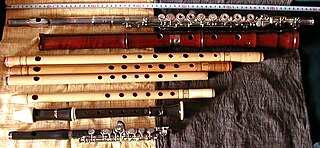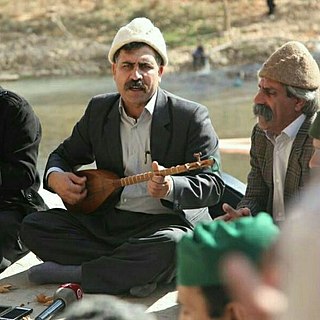
The clarinet is a family of woodwind instruments. It has a single-reed mouthpiece, a straight, cylindrical tube with an almost cylindrical bore, and a flared bell. A person who plays a clarinet is called a clarinetist.

The flute is a family of musical instruments in the woodwind group. Unlike woodwind instruments with reeds, a flute is an aerophone or reedless wind instrument that produces its sound from the flow of air across an opening. According to the instrument classification of Hornbostel–Sachs, flutes are categorized as edge-blown aerophones. A musician who plays the flute can be referred to as a flute player, flautist, flutist or, less commonly, fluter or flutenist.

The ocarina is an ancient wind musical instrument—a type of vessel flute. Variations exist, but a typical ocarina is an enclosed space with four to twelve finger holes and a mouthpiece that projects from the body. It is traditionally made from clay or ceramic, but other materials are also used—such as plastic, wood, glass, metal, or bone.

The kaval is a chromatic end-blown flute traditionally played throughout the Balkans and Anatolia. The kaval is primarily associated with mountain shepherds.

The zurna, is a wind instrument played in central Eurasia, western Asia and parts of North Africa. It is usually accompanied by a davul in Anatolian and Assyrian folk music.

The davul, tapan, atabal or tabl is a large double-headed drum that is played with mallets. It has many names depending on the country and region. These drums are commonly used in the music of Middle East. These drums have both a deep bass sound and a thin treble sound due to their construction and playing style, where different heads and sticks are used to produce different sounds on the same drum.

A flue pipe is an organ pipe that produces sound through the vibration of air molecules, in the same manner as a recorder or a whistle. Air under pressure is driven through a flue and against a sharp lip called a labium, causing the column of air in the pipe to resonate at a frequency determined by the pipe length. Thus, there are no moving parts in a flue pipe. This is in contrast to reed pipes, whose sound is driven by beating reeds, as in a clarinet. Flue pipes are common components of pipe organs.

The term double clarinet refers to any of several woodwind instruments consisting of two parallel pipes made of cane, bird bone, or metal, played simultaneously, with a single reed for each. Commonly, there are five or six tone holes in each pipe, or holes in only one pipe while the other acts as a drone, and the reeds are either cut from the body of the instrument or created by inserting smaller, slit tubes into the ends of the pipes. The player typically uses circular breathing.

An overtone flute is a type of a flute that is designed to play in the upper harmonics, typically well above the two or three harmonics that are the practical limit for most woodwind instruments.

A pipe is a tubular wind instrument in general, or various specific wind instruments. The word is an onomatopoeia, and comes from the tone which can resemble that of a bird chirping.

The fujara originated in central Slovakia as a large sophisticated folk shepherd's overtone fipple flute of unique design. It is technically a contrabass in the tabor pipe class.

A gaida is a bagpipe from the Balkans and Southeast Europe. Southeastern European bagpipes known as gaida include: the Albanian: gajde, Aromanian: gaidã, Bulgarian: гайда, Greek: γκάιντα or τσαμπούνα, Macedonian: гајда (gayda), Serbo-Croatian: gajde/гајдe, Slovak: gajdy, Turkish: gayda also tulum.
The frula, also known as svirala (свирала) or jedinka, is a musical instrument which resembles a medium sized flute, traditionally played in Serbia. It is typically made of wood and has six holes. It is an end-blown aerophone. The frula is a traditional instrument of shepherds, who would play while tending their flocks.

The term Tanbur can refer to various long-necked, string instruments originating in Mesopotamia, Southern or Central Asia. According to the New Grove Dictionary of Music and Musicians, "terminology presents a complicated situation. Nowadays the term tanbur is applied to a variety of distinct and related long-necked lutes used in art and folk traditions. Similar or identical instruments are also known by other terms." These instruments are used in the traditional music of Iran, India, Kurdistan, Armenia, Afghanistan, Pakistan, Turkey, Tajikistan, Kazakhstan, and Uzbekistan.
The kāwālā is an end-blown cane flute used in Arabic music. It is similar to the ney but has six finger holes, while the ney has seven. The kawala comes in up to nine different sizes, according to the maqam.
Swirel is an old folk Russian wind instrument of the end-blown flute type. Classification: Aerophone-Whistle Flute-recorder. In the Old Rus' this instrument was made either of hollow reed or cylindrical wood branches. A legend says that Lel', son of the Slavic goddess of love Lada was a svirel player. In spring he would make his svirel of birch branches.

A wind instrument is a musical instrument that contains some type of resonator in which a column of air is set into vibration by the player blowing into a mouthpiece set at or near the end of the resonator. The pitch of the vibration is determined by the length of the tube and by manual modifications of the effective length of the vibrating column of air. In the case of some wind instruments, sound is produced by blowing through a reed; others require buzzing into a metal mouthpiece, while yet others require the player to blow into a hole at an edge, which splits the air column and creates the sound.
Hmong music is an important part of the culture of the Hmong people, an ethnic group from southeast Asia. Because the Hmong language is tonal, there is a close connection between Hmong music and the spoken language. Music is an important part of Hmong life, played for entertainment, for welcoming guests, and at weddings and funerals. Hmong musical instruments includes flutes such as the dra, leaves also called nblaw, and the qeej or gaeng, a type of mouth organ.

Mechanical music technology is the use of any device, mechanism, machine or tool by a musician or composer to make or perform music; to compose, notate, play back or record songs or pieces; or to analyze or edit music. The earliest known applications of technology to music was prehistoric peoples' use of a tool to hand-drill holes in bones to make simple flutes. Ancient Egyptians developed stringed instruments, such as harps, lyres and lutes, which required making thin strings and some type of peg system for adjusting the pitch of the strings. Ancient Egyptians also used wind instruments such as double clarinets and percussion instruments such as cymbals. In Ancient Greece, instruments included the double-reed aulos and the lyre. Numerous instruments are referred to in the Bible, including the horn, pipe, lyre, harp, and bagpipe. During Biblical times, the cornet, flute, horn, organ, pipe, and trumpet were also used. During the Middle Ages, hand-written music notation was developed to write down the notes of religious Plainchant melodies; this notation enabled the Catholic church to disseminate the same chant melodies across its entire empire.
The fyell brezi, also known as fyell shoke or fyell bariu is an aerophone end-blown instrument traditionally played throughout Albania and other Albanian inhabited lands. The instrument is commonly associated with shepherds of the Albanian highlands, commonly referred to as the Dukagjin highlands.















